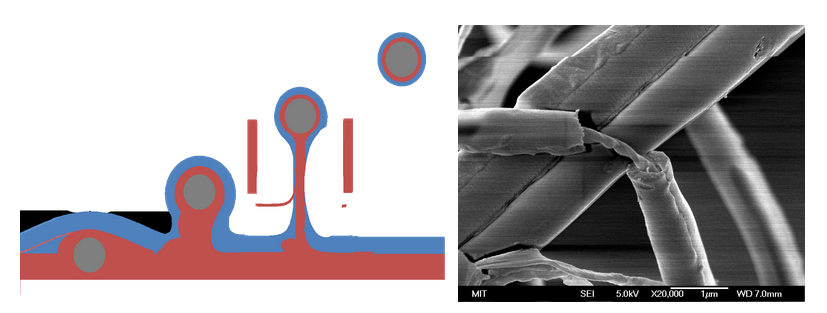
Soon a point is reached where the electrostatic repulsion from the accumulated charge is larger than the surface tension and this results in an extremely fine jet of the liquid.

When a polymer solution contained in a bulk reservoir, typically a syringe tipped with a needle, is connected to a high-voltage power source, electric charge accumulates on the surface of the liquid. Electrospinning is a method of manufacturing extremely fine fibers with diameters on the order of nanometers. So the researchers turned to an option called coaxial electrospinning. “Worse still, this option offers insufficient flexibility for any realistically wearable application.” “The problem here has been that the manufacturing methods for phase-change micro-capsules are complex and very costly,” said Hideaki Morikawa, corresponding author of the paper and an advanced textiles engineer with the Institute for Fiber Engineering at Shinshu University.

A number of different strategies, including microencapsulation (in which the PCM such as paraffin is coated in extremely small capsules), have been attempted to improve the ‘packaging efficiency’ to overcome the rigidity and leakage problems. Unfortunately, the inherently solid rigidity of PCMs in their solid form and leakage when liquid has so far hindered their application in the wearable thermal regulation field. Then heat is released when the temperature reaches paraffin’s freezing point.

When the temperature of the environment around the paraffin reaches its melting point, its physical state changes from solid to liquid, which involves an absorption of heat. One such material is paraffin, which can in principle be incorporated into a textile material in different ways. Such fabrics often make use of phase-change materials (PCMs) that can store and later release large amounts of heat when the material changes phase (or state of matter, for example, from solid to liquid). These fabrics can directly manage the temperature of localized areas around the body. One option to relieve the heat or cold stress of such workers, or anyone else, from athletes to travellers, who experience such discomfort, is the emerging technology of personal thermal management textiles. A sweater will keep a worker warm in a cold meat locker, but could overheat the same worker when they leave that space. Such regular temperature changes are not only uncomfortable but can cause illness or even injury, and require a cumbersome constant change of clothing. Cold storage, ice rinks, steel forges, bakeries, and many other job sites require workers to make frequent transitions between different and sometimes extreme temperatures.

Many occupations, from firefighters to farmworkers, involve harsh hot or cold environments. Combining the threads with electrothermal and photothermal coatings that enhance the effect, they have in essence developed a fabric that can both quickly cool the wearer down and warm them up as conditions change.Ī paper describing the manufacturing technique appeared in the American Chemical Society journal ACS Nano on August 10. Materials scientists have designed an advanced textile with nano-scale threads containing in their core a phase-change material that can store and release large amounts of heat when the material changes phase from liquid to solid. Textile engineers have developed a fabric woven out of ultra-fine nano-threads made in part of phase-change materials and other advanced substances that combine to produce a fabric that can respond to changing temperatures to heat up and cool down its wearer depending on need. COPYRIGHT © 2022, AMERICAN CHEMICAL SOCIETY.


 0 kommentar(er)
0 kommentar(er)
